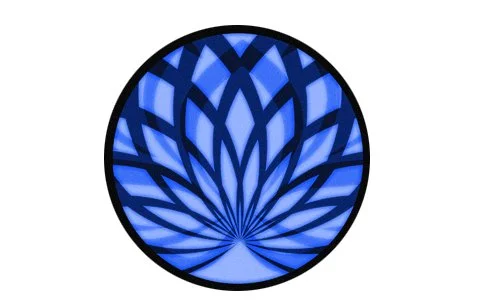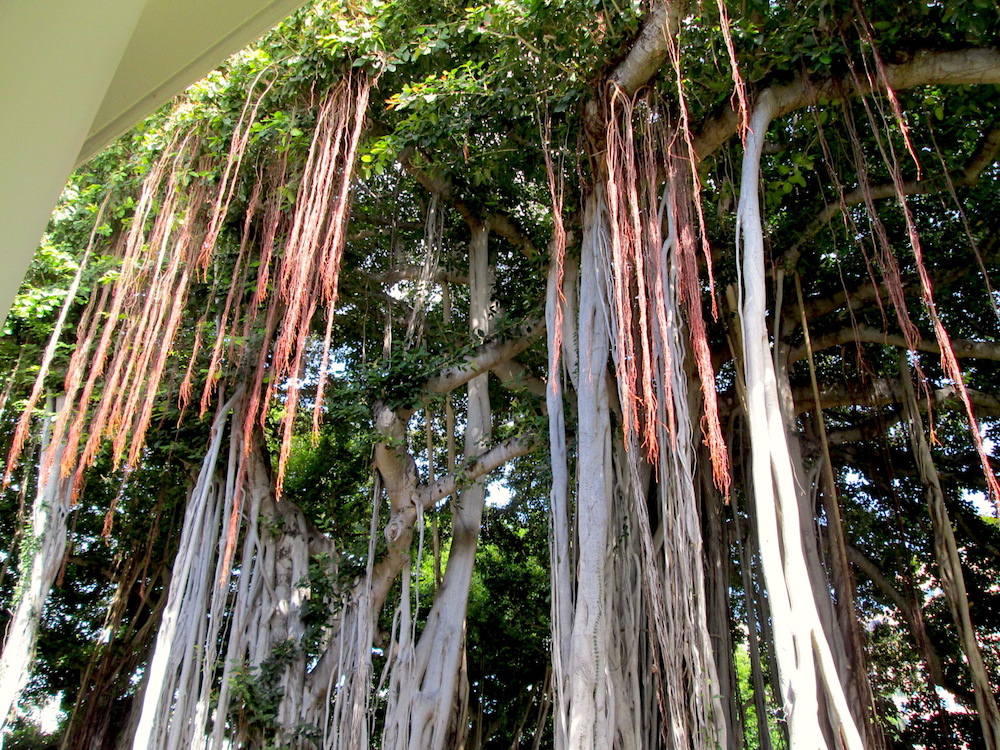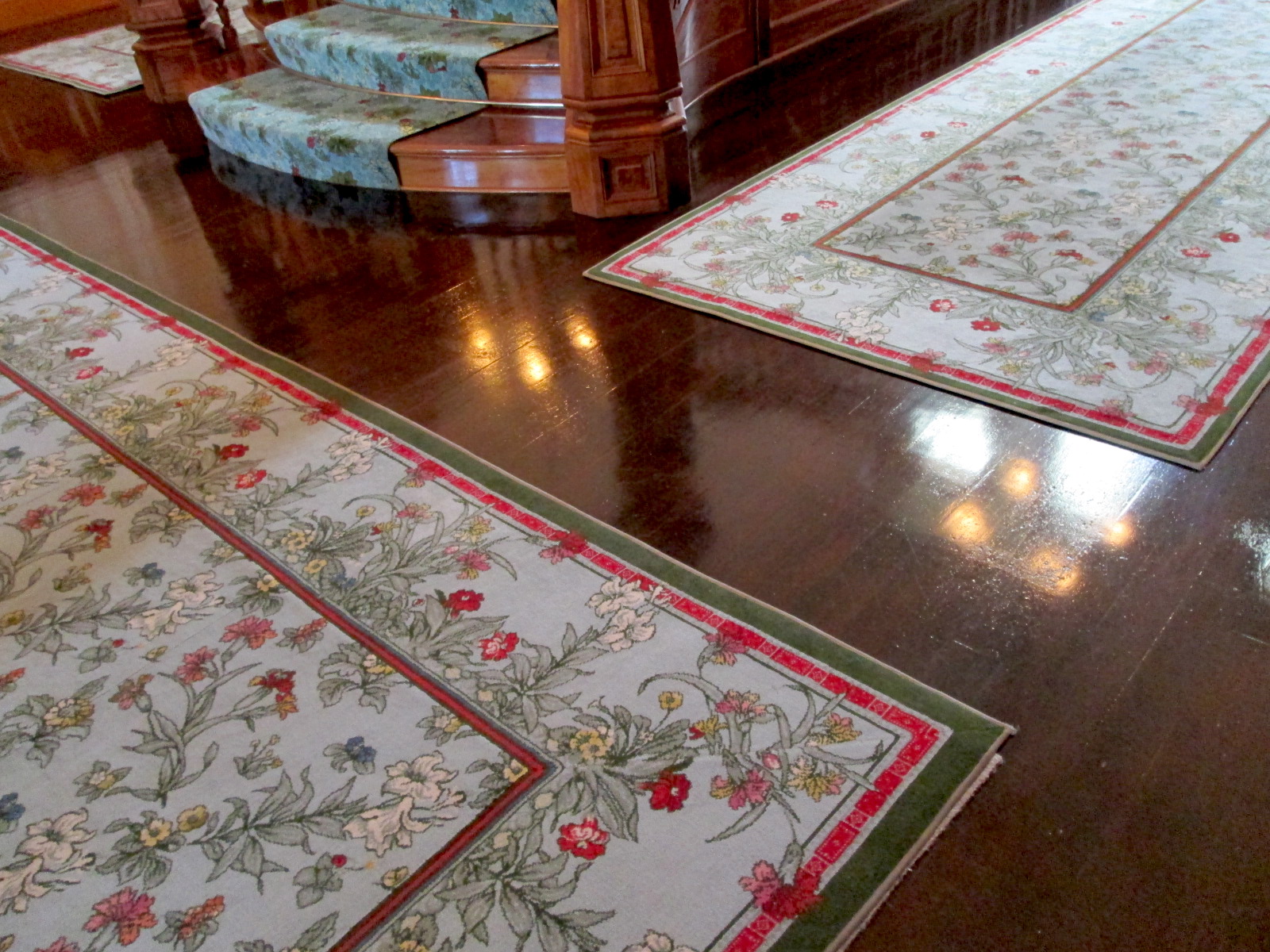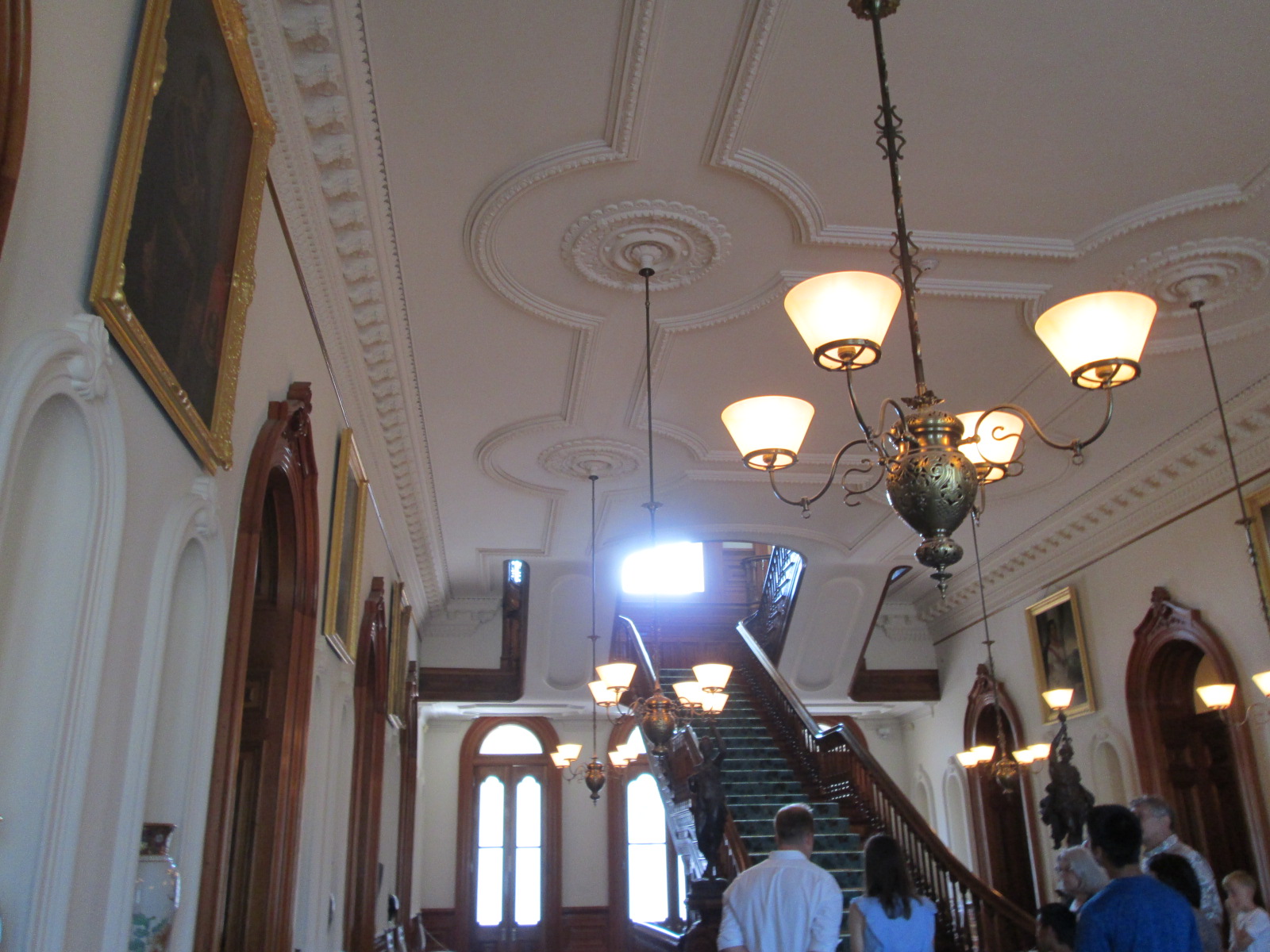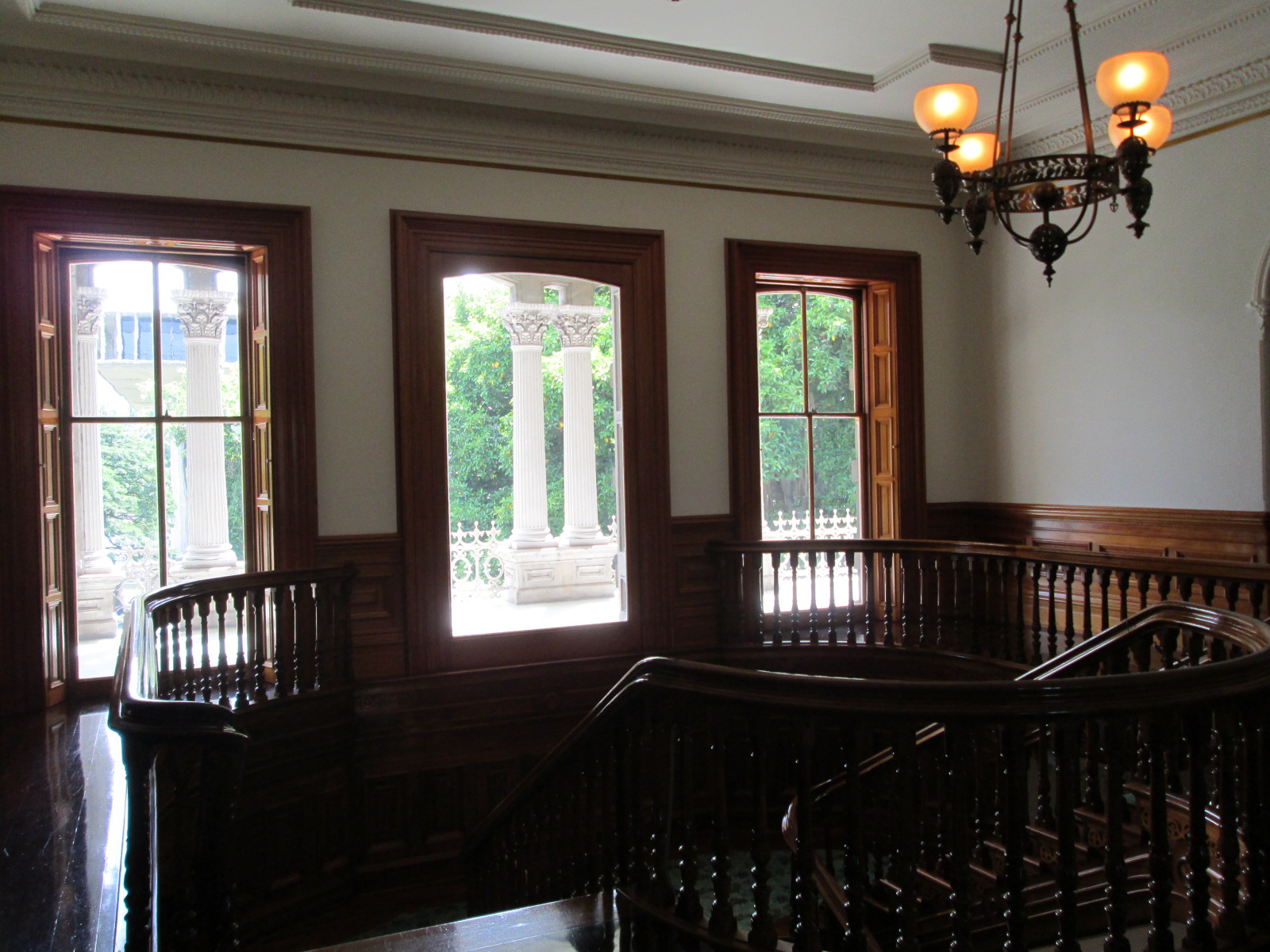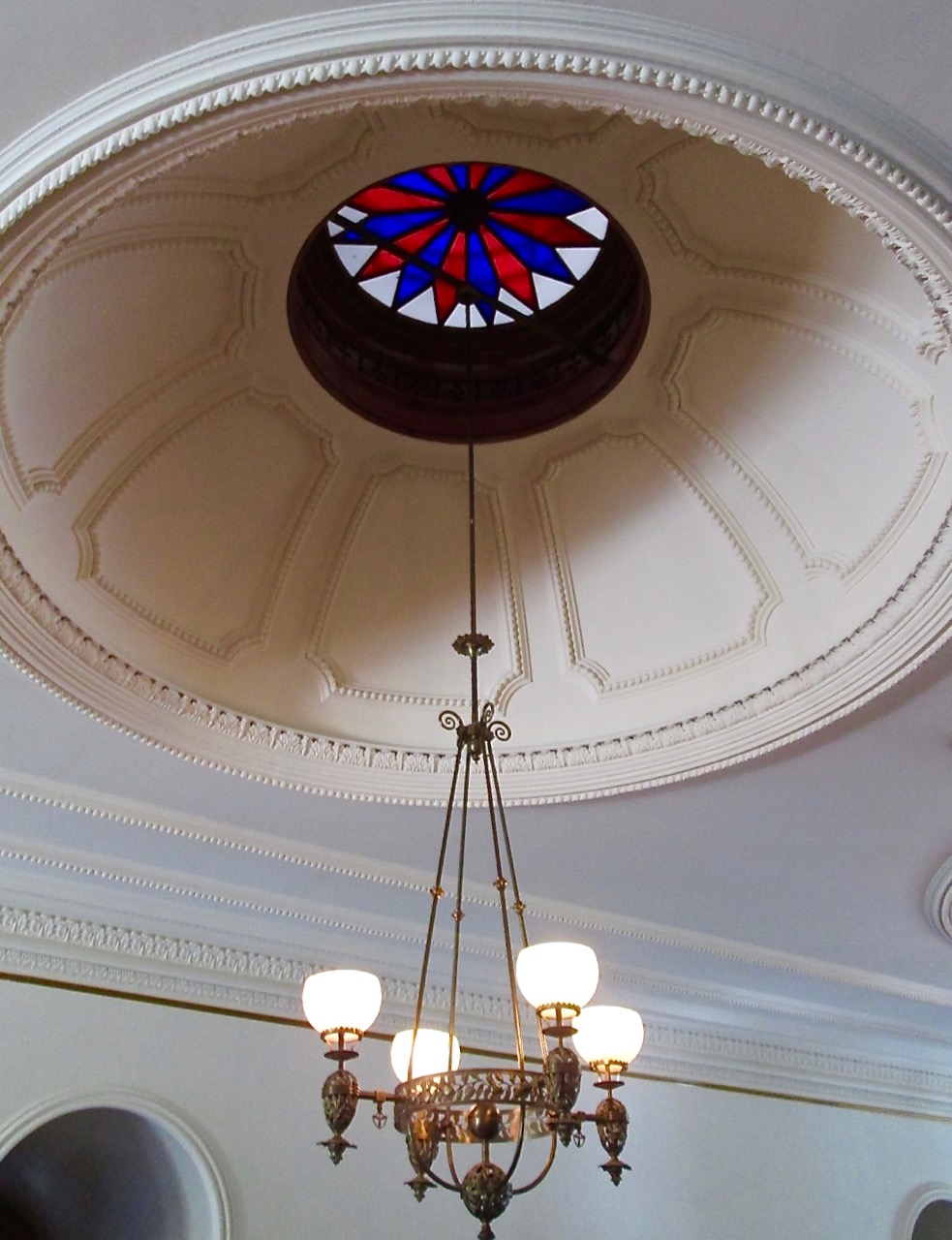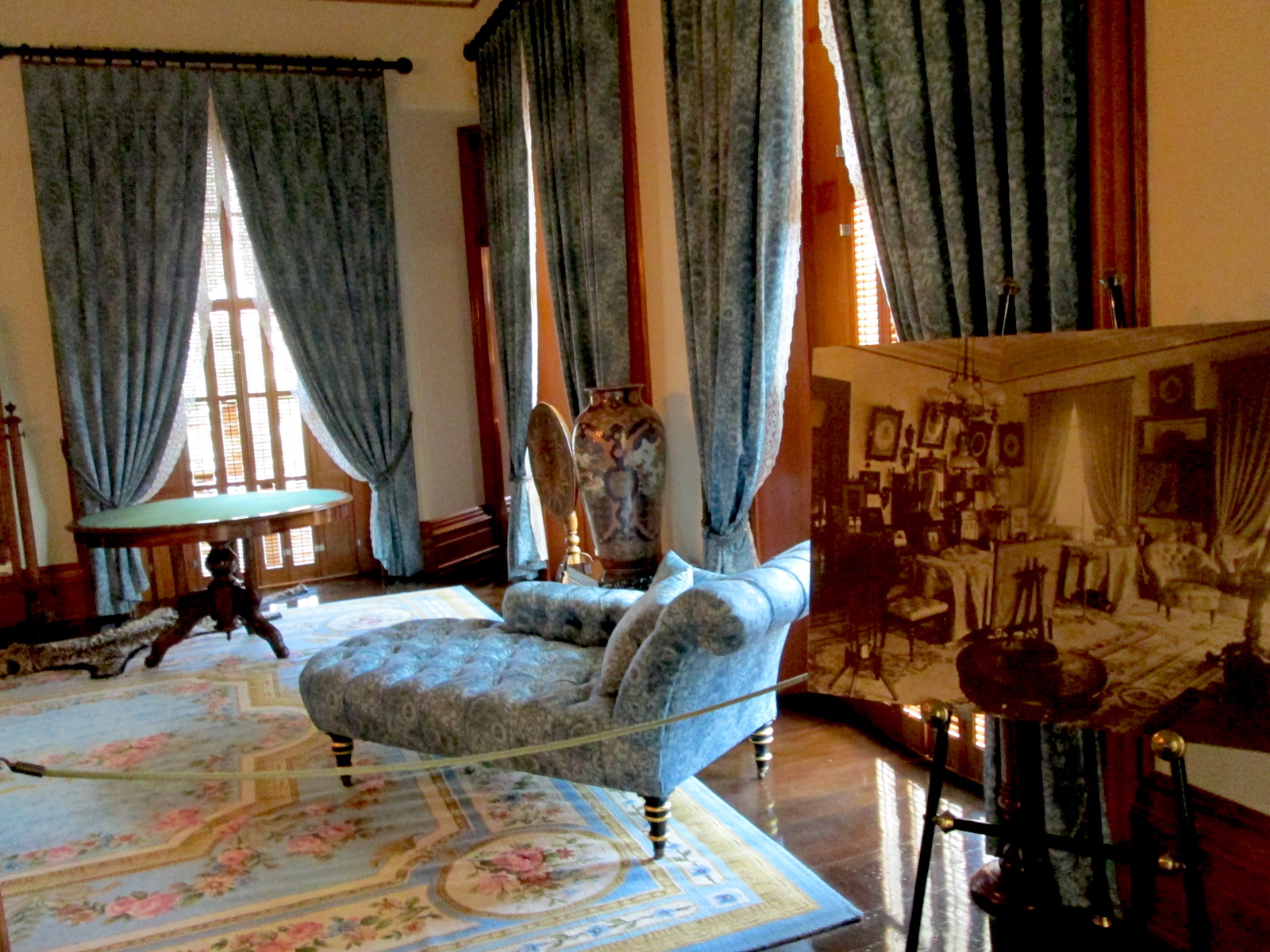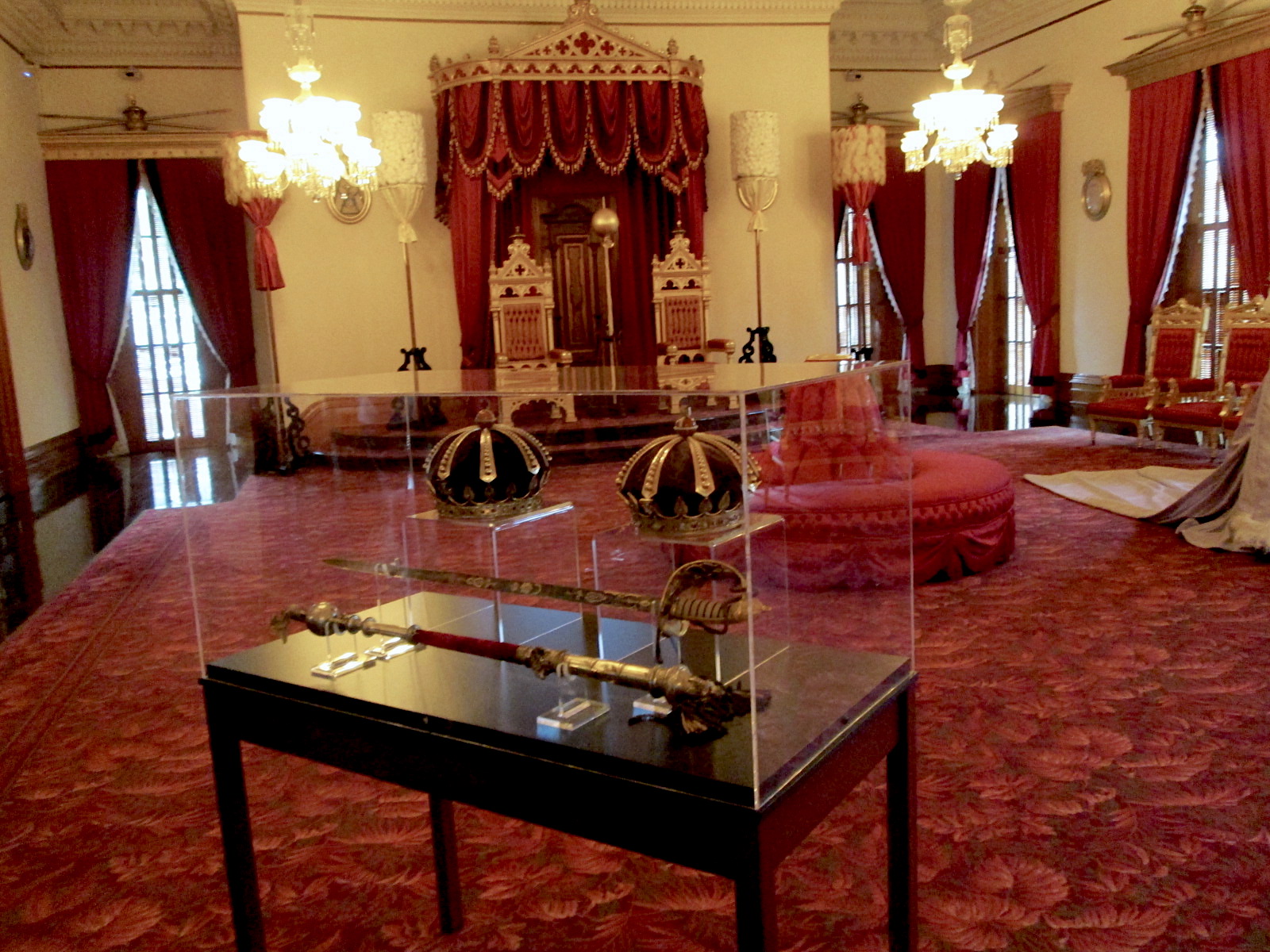I’ve been fascinated by the flights of these birds, which appear at dusk outside my window.
‘Iolani Palace visit
Thanks to Gary and Karen Mawyer, who were in town for the wedding of their son Daniel, we went on a tour of the palace. Shown in the first few pictures here are the stately banyan tree that grows on the palace grounds; falling from the limbs are stringy, red roots. See the site of Friends of ‘Iolani Palace to learn more about the historic landmark.
MS. ALIGNED 2: my teammates
Five stars
Vorticity
On Bill McKibben and Citizenship
The following are notes I made for a short essay that I never wrote.
At a talk that Bill McKibben, founder of 350.org, gave at the University of Hawai‘i in April, he said two things that I hope to use as guiding principles in 2014:
- It's in our role as citizens that we have fallen down.
- We should not spend time perfecting our own lives.
These acts are entwined, of course: if we attempt to be good citizens, we will spend less time "perfecting" our individual lives; and if we spend our time in ways that are beneficial to society, we will realize the good citizenship on which societies rest.
The fact that citizenship comes not only with rights and privileges but also with duties and responsibilities can easily escape those of us who live in a consumer-driven place like the United States. The U.S. economy depends on us "perfecting" our lives by acquiring nice cars, assuming mortgages to buy homes, wearing the latest fashions in shoes and clothes, going on vacation trips, amassing credit-card debt, and so forth.
Rather than use the currency of money, McKibben suggests we develop a new kind: that of social movements based on the exercise of good citizenship.
The BFG
Just as there are levels of perception and reasoning, there might be levels of enchantment—the last different from the first two because levels of enchantment diminish as we get older. Steven Spielberg’s The BFG takes us back through those levels, and then—like the giant the film is about—gently returns us to the real world. The film is so artfully made—keeping one human foot in the real world and one giant foot in make-believe—that I found my watching, listening consciousness trying to merge with the storytelling point-of-view. This is one effect of Melissa Mathison’s rich adaptation of Roald Dahl’s children’s story, Steven Spielberg’s sensitive realization of her screenplay, and the chemistry—nay, magic—between the principal actors: Mark Rylance as BFG, and Ruby Barnhill as Sophie, the orphaned girl.
One of ten giants in what he calls Giant Country, BFG is unlike the others: he is smaller, does not eat meat, and, instead of being a hunter, is a servant of the human race, serving as their dreamcatcher. It is in carrying out his dreamcatching duties that he meets Sophie. Different from the other children, she has insomnia, walks the halls of the orphanage in the twilight hours, and smuggles books into her bed to read.
Soon after their meeting, BFG takes Sophie to the place where he catches dreams. It is nighttime, and we see an enormous tree and a crystal-clear lake. Dreams dart through the tree as it spreads across the sky like the heavens—its many long branches a constellation, and the dreams its stars. It is here that, at BFG’s urging, Sophie takes the first of two leaps, plunging into the lake and discovering the mirror world of the one above.
Later, Sophie tries to avoid capture by a meat-eating giant and hides in a large vegetable from BFG's garden, becoming saturated from head to toe in its gooey juices. When she emerges, she needs to be cleaned and to change her clothes. When BFG looked at her and determined what to do, I couldn’t help but think of the scene in Tim Burton’s Alice in Wonderland in which the Mad Hatter made a dress for Alice with a few Edward Scissorhands movements and a bit of cloth. Instead, BFG drenches her with water, then brings her a trunk in which he has stored some human clothes. He empties the trunk at her feet, and she chooses what to wear and changes beneath a blanket. Thinking about this, I see the cache of clothes as representing the relationship between BFG and the humans he tends as the dreamcatcher. Their worlds are in contact, but only in fragile and fleeting ways that leave each other untouched; all that remains of these times are a few artifacts, to be stored and forgotten. When Sophie, having chosen a plain dress and a red jacket with black braid, stands before BFG, memories rush across his face, and we sense some pain, loss. Sophie asks him to explain, but he shakes his head and doesn’t reply. This moment portends not only the joys of their friendship but also the sadness of their parting.
Eventually, BFG determines that Giant Country is too dangerous for Sophie and returns her to the orphanage. It is then that Sophie takes the second of her leaps, this time at the urging of her own heart.
The last part of the film has several surprising developments, and I won’t spoil The BFG for people by describing how they come to be. I’ll just provide a few details.
Sophie and BFG dine with the Queen at Buckingham Palace, and outrageous, giant-sized jokes of just the sort to tickle young funny bones occur. Shortly after, we see military planes and paratroopers in a pitched battle in Giant Country, but before this, one of the film’s best scenes takes place. In a quiet, meditative moment, BFG and Sophie discuss the future. All the tenderness that the story has woven about them is manifested in their gentle voices, the angle at which the sun strikes the hillside they sit on, and the soft wind. In Sophie’s contemplative look is a question about the permanence of the love she has developed for BFG.
Goodness (BFG) and Innocence (Sophie) are not only compatible but also meant for each other, and the certainty of this makes us better people when the movie concludes and we step back into the real world.
Think differently
Vulnerability
Nice to hear the story behind the art
When I met with my writing group three weeks ago, I saw a large painting of a young woman with a lei on a building nearby. I was pleased to find, by accident, this video on the artist: Sean Yoro.
Christmas 2015
Among the gifts I received this year were two hand-crafted vases. The glass one was from my friend Gary Mawyer, of Charlottesville. He writes, "The art glass is a mushroom vase with dichroic iridescent blue glass on the top of calcite glass. It is dated and signed by the artist on the bottom, and was picked up in an estate sale here." Depending on the lighting, the vase displays different colors, as these pictures show:
- The first was taken from the side with a flash.
- The second was taken from above with a flash.
- The third, also shot from above, was taken in natural lighting.
The second vase was given to me by Keith Yabusaki, a friend who has recently moved back to his family's home in Wahiawa. The vase came in an embroidered box with this note: "'Spirit of the Wine' Volcano Vase. The Spirit of Wine shape is known for its wide belly and narrow neck. The coloring of the Volcano vase is a purplish red glaze with various tints of light blue and moon white. Much like the islands of Hawaii, this piece must be crafted from extremely high temperatures before the brilliance and beauty are revealed.…The Spirit of the Wine has a very traditional shape from the Ming Dynasty which has been fused with the gorgeous purplish red glaze." The picture here was taken with a flash. Below, both vases are shown, shot from the side in natural lighting.
Yesterday, I was driving with my boyfriend through Kaka‘ako, and as I was gazing out the passenger window, I happened to spot a store called Antique Alley. I am always interested in looking at vintage, antique, and collectible pieces, so we stopped and went inside. I found a wonderful teapot that closely resembled one I had bought a year or two ago at George Kurisu's store on School Street. Both teapots are squat and small—about four inches in diameter and less than three inches tall—and both have a lid whose small handle has three vertical, equally spaced indents.
The teapot from Antique Alley is on the right and came with the plate shown. In addition to its resembling the other teapot, it was finished in an interesting way: except for the streaks and for the interior, it is unglazed, revealing the lovely clay color.
The handle of the teapot from Kurisu's shop looks like twigs bent and bound. The handle of the Antique Alley teapot is not the original one, unfortunately. Perhaps it was also made of bent and bound twigs?
I'm thrilled to have found two teapots so unusual and yet so similar, and I'm also delighted to have made the acquaintance of Andrew (aka Pake) Zane, owner of Antique Alley. Capturing him well, the video below is from a 2013 article by Alana Hong for Civil Beat. See you again soon, Mr. Zane.
An anthem for July 4 and every day
Lava
On Friday night, I saw the most enchanting short film: Lava, produced by James Ford Murphy, a member of the Pixar development team. In a television interview, Murphy said he came to Hawai‘i on his honeymoon twenty-five years ago and fell in love with the islands and their volcanoes. This affinity for Hawai‘i deepened when he heard Israel Kamakawiwo‘ole sing "Over the Rainbow."
Murphy began to study the ‘ukulele and read about volcanoes. He learned about Hawai‘i's geological history and Lō‘ihi, the active underwater volcano off the southeastern coast of the Big Island. While he continued to play the ‘ukulele, his reading about the volcanoes and his feelings for the islands and its music started to come together.
Murphy said his goal in making Lava was to capture the response he had had to Kamakawiwo‘ole's song. For me, the film was evocative not only of the Hawai‘i that exists now but also of the relatively unspoiled one I grew up in. The synergistic effect of the film's meticulous rendering of geographical forms and textures, the wonderful theme song (composed by Murphy and sung by Kuana Torres Kahele and Napua Greig), and the fresh and beautiful images was intense for me. Nostalgic feelings built in me as I watched it, and I am grateful to Murphy for that experience.
Endangered
Impossible not to admire this young woman's perseverance and her creative solution to helping the endangered flower endure.
Suicide
At my Work and Peace blog, I've written about Yi-Fu Tuan's book Who Am I: An Autobiography of Emotion, Mind, and Spirit (University of Wisconsin Press, 1999). The last paragraph of the book came to mind when I heard of Robin Williams's death. Tuan writes:
Let me end with an encapsulating anecdote. My memory for facts is not very good, as I have said, so I cannot remember the year or, precisely, the location of this event. It happened, in any case, well before I came to Wisconsin. I was alone, driving west late—well past midnight—across the sparsely settled landscapes of Nebraska. My car and another one ahead were the only two on the narrow highway. We kept each other company. I was never a confident driver, least of all in the dark, so I appreciated the front car's taillights, which guided me and made me feel safe. Just when I was beginning to take my companion for granted, his right-turn signal started to flicker. A friendly gesture, I thought, but also regrettable, because I was going to be left to myself. The car turned into a country lane. Henceforth, I had only my own headlights to show me the way. They illuminated a short stretch of the road and were then absorbed by a wall of darkness.
In the paragraph before, Tuan writes:
I yearn at times for a real home, permanence, continuing and dependable (that is, "mature") relationships, and even, in a weak moment, a firm reputation in an established discipline that can boast a long roster of scholars, a building of its own with paneled rooms, time-honored procedures for the granting of awards. But fate has decreed otherwise.
As the flyer shown above states, Yi-Fu Tuan is one of the most accomplished geographers in the world today. Yet his autobiography reveals to the reader a man with a deep loneliness, someone whose achievements cannot substitute for close and lasting relationships. Elsewhere in the pages of Who Am I? he writes of his own suicidal thoughts:
The last time I had coffee with Tom Boogaart, a graduate student on his way to Belgium to do research, he said almost casually, "Now that you have retired, I can see that you are eager to end your life." I was shaken. I didn't know I was such an open book. Or it might just be that Tom is an exceptionally penetrating reader, for no one else has suspected this morbid streak. Several years ago, I bought Final Exit (1991), which is a sort of handbook for "self-deliverance and assisted suicide." Reading it put me in the dumps, for the book made it obvious that suicide is not an option for me. As a child, I thought nothing of sticking a wriggly earthworm with the sharp point of a fish hook. I can't do that now. I find it hard now to swat a fly. If such tiny bundles of life are too alive for me to kill, what about a large warm body, a human being—me? The idea is preposterous. I don't have the guts to jump out of the window or shoot myself with a gun, and, as Final Exit makes clear, I don't have the technical competence for the gentler forms of self-destruction.
We now know the manner in which Robin Williams killed himself. To my mind, it seems as if he were carrying out a punishment, an execution. I read a few journalistic pieces at the time of his death, and the Guardian interview conducted by Decca Aitkenhead—which allowed the actor to speak in his own halting, circumspect way—seems prescient.
It is almost impossible to get anything coherent out of him about the film, or any of the issues it raises. He is vague, tangential and at times more or less incomprehensible—until the conversation turns to more personal matters, at which point he becomes lucid and forthcoming. What Williams really wants to talk about, it turns out, is his relapse into alcoholism, his rehab and his open-heart surgery.
* * *
My worry beforehand had been that Williams would be too wildly manic to make much sense. When he appeared on the Jonathan Ross show earlier this summer, he'd been vintage Williams—hyperactive to the point of deranged, ricocheting between voices, riffing off his internal dialogues. Off-camera, however, he is a different kettle of fish. His bearing is intensely Zen and almost mournful, and when he's not putting on voices he speaks in a low, tremulous baritone—as if on the verge of tears—that would work very well if he were delivering a funeral eulogy. He seems gentle and kind—even tender—but the overwhelming impression is one of sadness.
Even the detours into dialogue feel more like a reflex than irrepressible comic passion, and the freakish articulacy showcased in Good Morning Vietnam has gone. Quite often when he opens his mouth a slur of unrelated words come out, like a dozen different false starts tangled together, from which an actual sentence eventually finds its way out. For example, "So/Now/And then/Well/It/I—Sometimes I used to work just to work." It's like trying to tune into a long-wave radio station.
In explaining why his second marriage failed, Williams says, "You know, I was shameful, and you do stuff that causes disgust, and that's hard to recover from. You can say, 'I forgive you' and all that stuff, but it's not the same as recovering from it. It's not coming back."
Every action may bring someone considering suicide to the wall of darkness that Tuan evokes at the end of his book. Whether it's shame that causes one to remain there, or fear of dying that makes one pass through, is perhaps impossible to predict. Who would have predicted that Robin Williams would kill himself? A graduate student knew that Yi-Fu Tuan was contemplating suicide, but how many of us would have seen beyond the pleasant smile, the impressive scholarship?
TheBusyB continued
A friend commented recently that most blogs are solipsistic and not worth the time required to read them. I didn't feel she was commenting on my work, but I did find myself trying to determine what the value of writing is when readers easily dismiss one's efforts—or fail to recognize one has made any at all.
Some years ago, a writer said that after he was published, he went from being unknown to being mediocre. Given the choice, he concluded, he would have preferred the former. Is this the fate of most of us who write: to disappear in a world of mediocrity once we have a few readers—or, rather, have had a few readers?
And is a blog only for the writer, equipping him or her with a sense of audience when there is none of consequence? Providers such as Squarespace (which just introduced version 7 of its platform) try to enhance the reality of audience, readership by allowing blog keepers (if I may) to amass statistics on site visitors. Using what Squarespace calls metrics, keepers can get some sense of who their readers are. This reminds me, though, of a criticism of a methodology of particle physics I once heard (probably while watching Nova on PBS). A scientist said that bombarding particles with energy and charting their trajectories was as productive as putting a kangaroo in a dark room and bombarding it with tennis balls. Yes, some kind of information is yielded, but not the kind that is truly useful—or wanted.
On those days when the metrics tell me no one has visited this site, I feel let down, yes. I also feel I have let others down by not being interesting, intelligent, charming, or entertaining. On those days when the number is 1, I wonder if my own visit—on another computer—has been tracked. Of course, IP addresses are listed in the logs, but these can be deceiving I've learned.
And then there are those days (today for example) when I've made modifications to the site and my own IP address is listed half a dozen, or ten, or fifteen times. This is not supposed to happen I'm told (the program is not supposed to count one's own visits), but it does. Though the IP address does not match that of the computer I'm using, I know it is mine because it appears for every page I've modified.
When I come across the blog of a writer who is entertaining—because he challenges me to think differently or because she evokes sweet remembrances of things past—I'm delighted. I realize my notions of what is possible—and what has to be—have become stale and limiting. I've written about two such blogs: those of Charlottesville writer Gary Mawyer and Karen, his wife, a retired attorney. Shops, gardens, auctions, books, travels—these become departure points for adventures of the mind and heart. Here is an excerpt from one of Gary's first posts, "Sandstone and the Gulfs of Time":
Jorge Luis Borges’ “The Book of Sand” is one of my favorite stories. In this story a fictional Borges purchases at fabulous price a mystical book with an infinite number of pages—a frightening Lovecraftian artifact which despite its measureless length must rationally enclose an unimaginable middle page. In the end he hides it—from himself, as much as anyone. Strangely enough, there really is a book of sand, divided into folios of outwash and deposition. While the full scope of the real book of sand is utterly beyond the scale of human life and indeed beyond the scale of human existence as a species, we actually can turn some of the pages—they make great flowerbeds—although, like Borges’ narrator, we find ourselves limited to the parts we think we can understand and maybe invited to wonder what we are, after all, in terms of such gulfs of time.
Michael Schmicker, a writer and investigative journalist, started corresponding with me after being referred by a mutual friend for some editing work. I have looked at his Google+ blog and like the buffet-style format. It is reminiscent of Facebook's layout but is not cluttered, confusing, and riddled with advertising. Though it may be difficult to determine the chronological order of entries, he writes frequently enough that the reader doesn't feel lost in a timeless space. Going down the columns is instead pleasant, like doing a leisurely hopscotch. Also, Schmicker is a good amateur photographer, capturing mainly clouds (he belongs to a group of cloud watchers and recorders), and often pairs his images with literary quotations (Antoine de Saint-Exupery and Rabindranath Tagore, to name a few sources). This is not a new technique, of course, but Schmicker has a light, deft touch and the synergistic effect is sometimes more complicated than it first appears.
Before I end this post, I want to comment on the header image for creative trouble. Eddie Aikau was a beloved surfer, lifeguard, and Hokule‘a crew member who was lost at sea while attempting to get help for his shipmates. The local saying "Eddie would go" memorializes the fearless, large-hearted way he lived. There have been many takes on this saying, my favorite probably being "Mom would go." I changed it a bit, imagining Aikau diving into the biggest manuscripts, unafraid to do what needs to be done.
This is the image referred to in the paragraph above. The header image has since changed.
TheBusyB
TheBusyB is the name of a service I was thinking of offering at my small business, Peak Services. My thought was that I could help people develop and maintain their blogs by doing some of their research (e.g., looking for web sites or pages they might want to share), suggesting topics for posts, collecting images, audio clips, or video clips of possible use, helping them outline their writing and clarify their purpose, and so forth.
Web technology is advancing so rapidly—driven in large part by competition among rival developers—that anyone who can email can also blog. You no longer need to log in to your blog, create a post, and publish it. You can now send an email message to a mailbox linked to your blog and publish your posts easily and immediately. Despite this, I thought some people might want TheBusyB service.
Japanese teapot from an antique store.
This line of thinking was inspired by a friend and fellow writer whose publisher had suggested she create a blog to attract people who might be interested in reading and purchasing her book. I have another writer friend who has just finished a novel, and it was possible, I thought, that she too might be asked to create a blog by the publisher of her book.
But do we need more blogs? And will these actually produce the intended results, e.g., motivate people to buy books?
In May of last year, I created Some Perfect Future. My desire was to create a site that would not focus on me but would instead present my work and ideas—that is, a site that would record how I thought, created, and, to some degree, lived. Anyone who knows me well knows that my thinking and writing have a strong didactic element. This, I hoped, would give my site strength and interest but not overpower it.
In the fourteen months that have passed since the creation of Some Perfect Future, I feel I have learned much about the power of sites and blogs to influence and inform people's thinking. I have also learned that doing yields wisdom and knowledge and, consequently, there is yet a great deal for me to do. I feel that my site has not been influential, but it has been able to present an alternative way of writing, of creating art, and of evaluating those acts in the large context of living.
Do we need more blogs? I would say no, but then as soon as these words are uttered, new blogs will come along to entrance, entertain, and re-envision the concept and purpose of blogs. Can blogs produce the intended results? This is a complex question whose answer depends not only on the quality of the blogger's work but also on the willingness of visitors to respond to what they read and encounter.
I will return to this subject in a future post.
Opening video
Created this for a multimedia project that I also designed the logo for (appears near the end).
What the world needs now
is thoughts, more thoughts…The start of a new blog with, I hope, thoughts worth sharing. A bit subversive, risky, experimental perhaps.
The image below is a still from the film Blancanieves. I had it on the home page for a while, along with this text:
A 2011 film by Pablo Berger, who has said, "for me Blancanieves is valid if it only serves as a terrorist act, to remind directors what makes cinema an art form—visual storytelling, editing, music, those elements that were dominant before 'moving images' became 'talking pictures.'"
Watching the trailer again, I'm reminded of the black-and-white films of Swedish filmmaker Ingmar Bergman, in particular The Seventh Seal.
